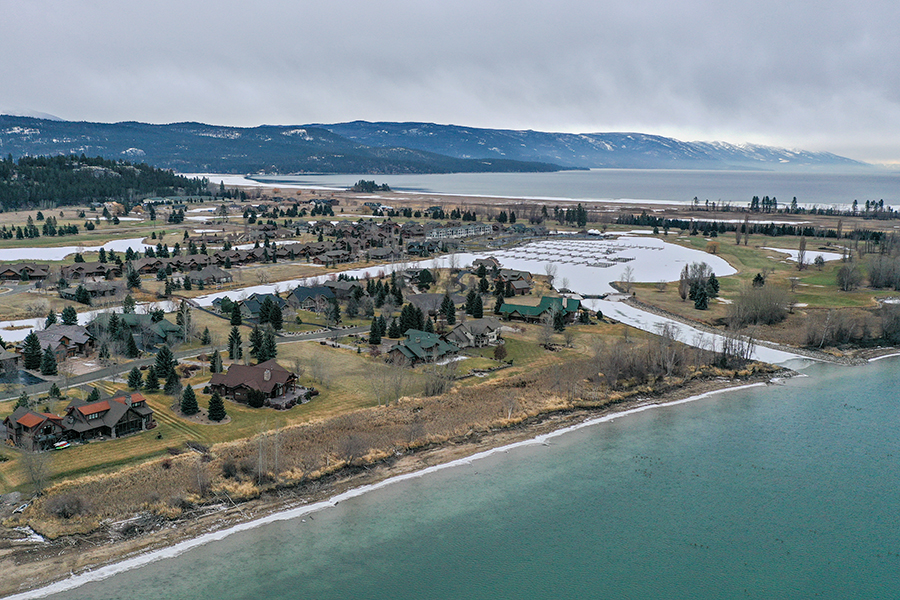The Economic Value of Lakes
Study shows that Flathead and Whitefish lakes contribute large sums through property values to the local tax base, but their allure hinges on maintaining their water quality
By Tristan Scott
The clear and pristine water quality of Flathead and Whitefish lakes has delivered untold economic benefits to local communities for decades, both in tourism spending and by producing substantial tax revenue for local and state governments.
Seeking a way to economically quantify the aesthetic benefits that landowners derive from living on or near lakes with exceptional water quality, researchers from the University of Montana’s Flathead Lake Biological Station and Whitefish Lake Institute this week announced the results of a study estimating the benefits that Flathead Lake and Whitefish Lake impart on home values, according to Nanette Nelson, a research economist for the Flathead Lake Biological Station (FLBS) and lead author of the study.
“Our results suggest that highly desirable lakes like Flathead and Whitefish lakes enhance surrounding property values thereby contributing significantly to the local tax base and economy of both lake-based communities,” Nelson said.
The study dataset included over 7,000 “arms-length” sales transactions (the study omitted short-sales and bank-owned sales) occurring within two kilometers (about a mile and a quarter) of Whitefish Lake and Flathead Lake between 2004 and 2018. Results revealed a 254% or $1.3 million average premium for the same home on the lakefront of Whitefish Lake versus two kilometers from the lake. Flathead Lake exhibited a 114% or $0.5 million average premium. Summing across all properties within two kilometers of both lakes yielded aggregate premiums upwards of $3 billion, according to the study.
The effect of Flathead Lake on surrounding lakefront parcels equaled between $12 million and $17 million in property tax revenues, while Whitefish Lake generated between $5 million and $8 million.
“This is important because in the state of Montana, over 94% of local government and school district tax collections are derived from property taxes,” the study notes.
“This study reveals the economic importance of maintaining water quality in our lakes,” said Lori Curtis, science and education director for the Whitefish Lake Institute (WLI) and co-author of the study. “Scientists from the Bio Station and WLI conduct research and continuously monitor the health of the two lakes, engage students in water quality education, and make recommendations to help citizens and leaders make informed resource management decisions. These study results provide us with an economic argument in communicating the significance of maintaining water quality and of our work.”
The significance of the monetary gains that the study tracked also emphasize what’s at stake should water quality be degraded in the watershed due to excess nutrient loading from increasing population density and associated development pressures, Curtis and Nelson both stressed.
Over the past decade, Flathead County grew by 14.2%, according the U.S. Census Bureau. As more people move into the watershed, greater amounts of nitrogen and phosphorus flow into surface waters, thereby increasing the pressure on rivers and lakes to assimilate the increased nutrient levels.
As the oldest biological field station in the Western Hemisphere, the Flathead institution has served as the “Sentinel of the Lake” since 1899, tracking water quality, influencing sweeping change in local environmental practices and gathering a groundswell of data.
In 1977, it instituted a scientifically rigorous monitoring program that served as the first line of defense against current and future threats to the health and quality of the Flathead watershed. These threats range from aquatic invasive species — like zebra and quagga mussels, first detected in the Missouri River Basin of Montana in 2016 — to nutrient and biological pollution from degraded shoreline septic systems.
Research conducted at FLBS has been an informative force behind significant water-quality conservation achievements, including the ban of phosphorus-containing detergents and the prevention of mining in the upper North Fork Flathead River. Flathead Lake continues to defy national trends as a healthy blue body of water.
But in the mid-80s, pioneering new research at the Flathead Lake station pointed to phosphorus as the key nutrient causing increased algal growth in the lake. It also identified phosphate laundry detergents as a relatively small but potent source of the biologically active compound entering the Flathead river and lake system in treated sewage effluent.
The research prompted sprawling changes to how municipal governments treated sewage in the Flathead Valley, particularly in Kalispell and Evergreen, and, coupled with the increase of algal blooms visible on Flathead Lake, produced a cascade of community-wide initiatives aimed at protecting the water quality of Flathead Lake.
Still, the list of other, more harmful sources of water-quality degradation is long, and includes storm-water runoff into the lake, the Flathead River and its tributaries from roads and parking lots, which are a primary source of nutrient loading that causes algae blooms and other symptoms of degraded water quality, according to the FLBS.
“Land use, planning, and development decisions are locally driven,” according to the new study. “Whether these policies improve or decrease locals’ welfare is contingent on whether the benefits of additional development outweigh the costs. As we have quantified herein, one potential cost is degraded water quality. Consequently, the value of maintaining water quality should be considered and integrated into local land use and planning.”